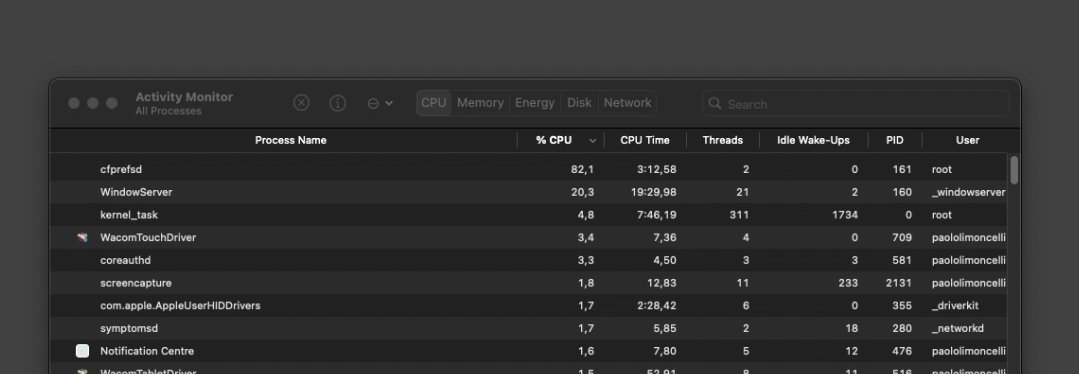-
Posts
1,083 -
Joined
Contact Methods
-
Website URL
http://www.ux-designstudio.com
-
Skype
paolo.limoncelli
Profile Information
-
Gender
Male
-
Location
Italy
-
Interests
http://www.daub-brushes.com
Recent Profile Visitors
8,446 profile views
-
 MangaAddict reacted to a post in a topic:
Color palettes
MangaAddict reacted to a post in a topic:
Color palettes
-
The use case you've described needs sub-pixel snapping... And you're no more in a "real" pixel scenario... 🙃 Turning off and using a classic grid snapping works best in this case. I personally always avoid "open" vector lines, it is not a good design strategy for pixel perfect requirements, rounding errors are there and it takes time to double check stuff... No matter which APP are you using.
-
 paolo.limoncelli reacted to a post in a topic:
Understanding Pixel Alignment, resample methods and effect on sharpness / blurriness
paolo.limoncelli reacted to a post in a topic:
Understanding Pixel Alignment, resample methods and effect on sharpness / blurriness
-
The use case is still pixel perfect design, I know it could sound strange but sometimes you have to deal with non pixel perfect alignment too... If you set Force Pixel Alignment for new assets, you could need MBWP off to fix optical alignment or find a different anti-alias rendering for stuff which is off-grid by design. This is the case o certain fonts and logos, whereas pixel perfect is not possible and a trade off is needed. By Pixel Perfect design I do not mean pixel art, but mainly UI design for OEM.
-
I should have better clarified... Sorry. Force Pixel Alignment and Move By Whole Pixels are both very needed if you start a project with pixel perfect requirements. This means that you are "creating" something from scratch: blank canvas, start drawing stuff... Obviously if you turn MBWP ON when your starting project is not pixel perfect, it will retain the non pixel perfect alignment... As you correctly said, it could make things even worse.
-
 Return reacted to a post in a topic:
Understanding Pixel Alignment, resample methods and effect on sharpness / blurriness
Return reacted to a post in a topic:
Understanding Pixel Alignment, resample methods and effect on sharpness / blurriness
-
Yes I well know... We've been using AD since 2014... 😜 It also creates problems with slices' dimensions in Export Persona. This is a long term glitch, and could be fixed to snap back to the closest integer (if the Force Pixel Alignment is ON), but could be very demanding for CPUs maybe? I guess switching complex vector art stuff could be tricky... Today I'm accustomed to the scroll-wheel over the input field to fix if weird things happen.
-
 _Th reacted to a post in a topic:
Size / Rotate objects to same
_Th reacted to a post in a topic:
Size / Rotate objects to same
-
 R.I.P. Affinity 26.03.2024 reacted to a post in a topic:
Size / Rotate objects to same
R.I.P. Affinity 26.03.2024 reacted to a post in a topic:
Size / Rotate objects to same
-
 ronnyb reacted to a post in a topic:
Size / Rotate objects to same
ronnyb reacted to a post in a topic:
Size / Rotate objects to same
-
 MmmMaarten reacted to a post in a topic:
Size / Rotate objects to same
MmmMaarten reacted to a post in a topic:
Size / Rotate objects to same
-
 Mithferion reacted to a post in a topic:
Size / Rotate objects to same
Mithferion reacted to a post in a topic:
Size / Rotate objects to same
-
Sure... And this si the case: different usage for different use cases. We can always use CMD+Z... Also... Those action buttons could be placed in the floating panel too. Search Studio works with the same UX pattern (Buttons for live actions...). Stroke Studio for example does not exist in AP, but works as modal only from context bar whereas APub and AD have both... Affinity allows a customisation of the toolbar exposing "basic" alignment, and these work without a "commit" action. Multiple way to access the same functions. Anyway, we're not asking to remove the dropdown, but to add a sidecar "non modal" version because with large canvases and lots of artboards these alignment and spacing functions will be easier to reach. 😀
-
 jmwellborn reacted to a post in a topic:
Size / Rotate objects to same
jmwellborn reacted to a post in a topic:
Size / Rotate objects to same
-
 GRAFKOM reacted to a post in a topic:
Size / Rotate objects to same
GRAFKOM reacted to a post in a topic:
Size / Rotate objects to same
-
 Affinityconfusesme reacted to a post in a topic:
Size / Rotate objects to same
Affinityconfusesme reacted to a post in a topic:
Size / Rotate objects to same
-
 paolo.limoncelli reacted to a post in a topic:
Size / Rotate objects to same
paolo.limoncelli reacted to a post in a topic:
Size / Rotate objects to same
-
Traceyg started following paolo.limoncelli
-
 paolo.limoncelli reacted to a post in a topic:
2.3 New features and improvements list
paolo.limoncelli reacted to a post in a topic:
2.3 New features and improvements list
-
Thank you!
-
 paolo.limoncelli reacted to a post in a topic:
Add Film Grain (free macros)
paolo.limoncelli reacted to a post in a topic:
Add Film Grain (free macros)
-
 paolo.limoncelli reacted to a post in a topic:
2.1 GM Build (2.1.0.1799)
paolo.limoncelli reacted to a post in a topic:
2.1 GM Build (2.1.0.1799)
-
 paolo.limoncelli reacted to a post in a topic:
Affinity Photo 2.1 1790 (RC2) and Ventura 13.3.1: Experiencing relevant Finder's lags
paolo.limoncelli reacted to a post in a topic:
Affinity Photo 2.1 1790 (RC2) and Ventura 13.3.1: Experiencing relevant Finder's lags
-
Hi @JonP Thanks to @MattP and Andy Tang I've solved in a very curious way. In Settings > Display changing brightness to 100% and turning "Automatically adjust brightness" OFF... ...wiped the slowness away.. I suggest to report this to Dev, because the correlation is weird... Also because AP only seems to be affected. Cheers, Paolo
-
Exactly. I sent both txt logs to @MattP I also tried to create a new macOS User, use the Safe Mode and nothing changes. Tried Disk Utility to check errors, cleaned all caches using both OnyX and Disk Doctor Pro. I also disabled Mission Control, Corners and other stuff... All apps in my macbook are fine and smooth, only AP (1.10.6, 2.0.4 and 2.1 Beta) has this weird behaviour... Unusable with Ventura... 😔
-
Hi Jon. The renaming of those plist files and folders does nothing... It definitely something dealing with AP because 1.x does the very same... I've tried to track the process cfprefsd I did these simple tasks: open APP create new document scroll to zoom the document minimise window enlarge window close The log of AP (any version) produces a 21 MB txt file The log of AD 2.1 RC2 produces a 385 KB txt file I'm far from being an expert here, but I guess and it is something dealing with AP only... Acting as Fox Mulder would... 😅 There is a sort of loop, AP writes something (or attempts to..) to the window server temporary folder lots of times... This loop starts when I interact with AP window. 10:55:19 getattrlist /Library/Preferences 0.000026 cfprefsd 10:55:19 access private/var/folders/zz/{folder name} 0.000012 cfprefsd 10:55:19 mkdir private/var/folders/zz/{folder name}/T 0.000006 cfprefsd 10:55:19 lstat64 te/var/folders/zz/{folder name}/T/TemporaryItems 0.000011 cfprefsd 10:55:19 fstatat64 te/var/folders/zz/{folder name}/T/TemporaryItems 0.000010 cfprefsd 10:55:19 openat 00000000000/T/TemporaryItems/com.apple.windowserver.plist.bKRBvZ9 0.000098 cfprefsd 10:55:19 fchown 0.000024 cfprefsd 10:55:19 fchmod 0.000017 cfprefsd 10:55:19 dup 0.000002 cfprefsd 10:55:19 fcntl 0.000004 cfprefsd 10:55:19 write 0.000047 cfprefsd 10:55:19 WrData[A] 00000000000/T/TemporaryItems/com.apple.windowserver.plist.bKRBvZ9 0.000168 W cfprefsd 10:55:19 fsync 0.000216 cfprefsd 10:55:19 fchown 0.000028 cfprefsd 10:55:19 fchmod 0.000016 cfprefsd 10:55:19 close 0.000007 cfprefsd 10:55:19 renameat 00000000000/T/TemporaryItems/com.apple.windowserver.plist.bKRBvZ9 0.000116 cfprefsd 10:55:19 close 0.000001 cfprefsd 10:55:19 close 0.000046 cfprefsd 10:55:19 close 0.000002 cfprefsd 10:55:19 open /Library/Preferences 0.000007 cfprefsd 10:55:19 openat [3]/com.apple.windowserver.plist 0.000023 cfprefsd 10:55:19 fcntl 0.000002 cfprefsd 10:55:19 fstatat64 [3]/com.apple.windowserver.plist 0.000007 cfprefsd 10:55:19 fstatat64 [3]/com.apple.windowserver.plist 0.000005 cfprefsd 10:55:19 dup 0.000001 cfprefsd 10:55:19 lseek 0.000001 cfprefsd 10:55:19 fstat64 0.000001 cfprefsd 10:55:19 read 0.000052 cfprefsd 10:55:19 read 0.000001 cfprefsd 10:55:19 fstat64 0.000001 cfprefsd 10:55:19 close 0.000001 cfprefsd And repeats so many times... Up to make a simple txt as big as 21MB In AD this loop appears only few times... Maybe AP uses a different routine and lacks of privileges/permissions that AD has?
-
It happens with Photo only, both 2.0.4 and 2.1 RC2 AD and APub are smooth I've noticed that with AP only the cfprefsd process reaches 82% of CPU Monitoring this I've noticed that if AP is open it has a low %. If I interact with Finder (Mission Control, Exposè, minimise and close the APP...) it jumps up to 80%. Now I'm erasing both 2.0 and 2.1 RC2. EDIT Now I've started with a "from scratch" installation of 2.1 RC2 only. Also I do not have 2.0.4 anymore... The behaviour is still there. Here the video of AD 2.1 RC2 showing a proper behaviour instead. AD_Not_Lagging.mov













